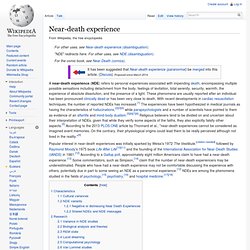

Stockholm syndrome. Stockholm syndrome, or capture-bonding, is a psychological phenomenon in which hostages express empathy and sympathy and have positive feelings toward their captors, sometimes to the point of defending and identifying with the captors.

These feelings are generally considered irrational in light of the danger or risk endured by the victims, who essentially mistake a lack of abuse from their captors for an act of kindness.[1][2] The FBI's Hostage Barricade Database System shows that roughly 8 percent of victims show evidence of Stockholm syndrome.[3] Stockholm syndrome can be seen as a form of traumatic bonding, which does not necessarily require a hostage scenario, but which describes "strong emotional ties that develop between two persons where one person intermittently harasses, beats, threatens, abuses, or intimidates the other. "[4] One commonly used hypothesis to explain the effect of Stockholm syndrome is based on Freudian theory.
Jerusalem syndrome. The Jerusalem syndrome is a group of mental phenomena involving the presence of either religiously themed obsessive[disambiguation needed] ideas, delusions or other psychosis-like experiences that are triggered by a visit to the city of Jerusalem.

It is not endemic to one single religion or denomination but has affected Jews, Christians and Muslims of many different backgrounds. The best known, although not the most prevalent, manifestation of the Jerusalem syndrome is the phenomenon whereby a person who seems previously balanced and devoid of any signs of psychopathology becomes psychotic after arriving in Jerusalem. The psychosis is characterised by an intense religious theme and typically resolves to full recovery after a few weeks or after being removed from the area. In a 2000 article in the British Journal of Psychiatry, Bar-El et al.[1] claim to have identified and described a specific syndrome which emerges in tourists with no previous psychiatric history.
History[edit] The 7 Sneakiest Ways Corporations Manipulated Human Behavior. #3.

Alka-Seltzer Doubles Their Dosage With a Theme Song Aqualux Alka-Seltzer is one of those weird products that seem to have no competitors. It comes with two tablets you drop into a glass of water, they dissolve, you drink it, you feel better. You may only know Alka-Seltzer as a slayer of hangovers, but if you are old enough to remember the 1970s and 1980s, you remember their TV ads absolutely bombarding prime time television. GettyOnly the best ads provoke the sinking feeling that someone might be screwing with you. Two tablets, that's all it takes. The Deviously Simple Plan: Up until the 1960s, the instructions only said to use one tablet, and that's all they showed people doing in the ads.
Getty"How do we give kids more heartburn? This is when inspiration struck: tell people to use two tablets, even if they didn't need to. Thus was born the "plop, plop, fizz, fizz" campaign, aka one of the greatest and most terrifying ad campaigns of all time: #2. Getty Getty"Johnnie Walker? #1. 5 Scientific Reasons Powerful People Will Always Suck. Power Gives You a False Belief in Your Abilities We know the powerful are risk-takers.

It comes with confidence, and that feeling that you can make the world bend to your will is the key ingredient in everything from politics to military strategy to playing NFL quarterback. But as it turns out, it works the other way, too. Put us in a position of power, and our perception of our abilities leaves all logic and reason behind. "Hut ... hut ... This next study happened at Stanford University. Then the researchers made them an offer: They could roll some dice, and if they correctly guessed their roll, they'd get cash. Dice appreciate a good blow, but it doesn't change how they roll. Yet, while both the less-powerful and the control group gave up the responsibility 30 to 40 percent of the time, a full 100 percent of the empowered subjects chose to roll themselves. But it doesn't end there.
George Ritchie - near-death experiences. George leaves his body and sees it lying in his bed.

He is not aware the dead body in his bed is his. Wanting eagerly to travel to Richmond, Virginia to start college, he finds himself flying in the air toward a city. He is not sure how he acquired these strange powers of flight and transparency. He arrives at a city and discovers he has lost his solidness. He flies back to the hospital and sees his lifeless body in the morgue and realizes he has died. Suddenly, Jesus appears emitting a tremendous light and love. Jesus gives him a tour of four different dimensions in the afterlife. In a house, Jesus shows him the spirit of a boy following a living teenage girl and begging for forgiveness while the girl is completely unaware of the boy's presence.
Jesus shows George a bar filled with sailors who are heavily drinking. Jesus takes him to a new dimension away from earth and shows him a kind of "receiving station" where spirits would arrive in a deep hypnotic sleep because of their beliefs. Near-death experience. Characteristics[edit] Researchers have identified the common elements that define near-death experiences.[24] Bruce Greyson argues that the general features of the experience include impressions of being outside one's physical body, visions of deceased relatives and religious figures, and transcendence of egotic and spatiotemporal boundaries.[25] Many different elements have been reported, though the exact elements tend to correspond with the cultural, philosophical, or religious beliefs of the person experiencing it: The traits of a classic NDE are as follows: The notice of unpleasant sound or noise (claimed by R.

Moody).[10]A sense/awareness of being dead.[24][26]A sense of peace, well-being and painlessness. Positive emotions.
The Interpretation of Dreams by Sigmund Freud.